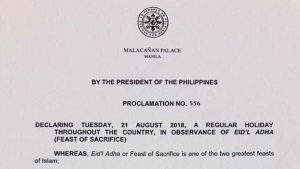We all saw a post that made everyone happy about having a 2-day long off-work week tomorrow. Unfortunately, August 22, 2018, did not actually turn out to be a national holiday. Everyone got excited when the news broke that both August 21, and August 22 would be a holiday. All employees had the expectation that they’ll be out of the office for those two (2) days. We’ll talk and have more information about that in a few minutes.
What is with August 21 and August 22?
Based on what we saw, August 21, 2018 (Tuesday) is Ninoy Aquino day while August 22, 2018 (Wednesday) is Eid al-Adha of the Muslims. Everyone thought that the Eid al-Adha would fall on the 22nd; turns out, it’s actually on the 21st.
As per the 269th Proclamation, the Ninoy Aquino Day is to be celebrated on the 21st of August each year and is considered to be a special non-working holiday. On the other hand, the Eid al-Adha has been proclaimed to be a regular national holiday.
Wait, what is Eid al-Adha?

Eid al-Adha or the Festival of Sacrifice is to be celebrated each year. This festival is held to honor Ibrahim (Abraham in the Christian Old Testament) and his willingness to be obedient to Allah’s wishes and commands.
Every year, the dates change. Based on study, it becomes 11 days earlier each year. It changes because the Islamic lunar calendar is solely based on the cycles of the moon which is totally different from the Gregorian calendar that we follow.
Next year, it is projected that the Eid al-Adha is to fall on the 11th of August, 2019.
Read: Academic Calendar For S.Y. 2018 – 2019
So what happened with the August 21, and August 22 hype?
Basically, August 21, 2018 contains two (2) holidays: Ninoy Aquino Day and Eid al-Adha. The 22nd, however, is not a holiday anymore. Therefore, there’s not enough reason for you not to go to work because the changes were announced a week back.
August 21, 2018, as a double holiday
Since we now know that the 21st is both a regular holiday and a special non-working holiday, we can now assume that:
- Since it’s a special holiday, you still get paid your regular salary even if you’re not in the office and;
- If you do, you should be paid correctly
This simply means that the 21st of August is considered as a double holiday (regular for Eid al-Adha and special non-working for the Ninoy Aquino Day)
What is the difference between regular holidays and special non-working holidays?
When talking about holidays, schools, colleges, and universities suspend classes when a holiday is observed in the Philippines. Whether it’s a regular or just a non-working holiday, no classes for students.
In the corporate world, however, it’s a totally different story.
Regular holidays
Regular holidays are holidays that usually have a fixed date like Christmas Day, New Year’s Day, Independence Day, etc. However, religious holidays like Maundy Thursday and Good Friday are not always the same since they’re of course “days” and we can’t assume that they’ll always fall on the same date. In addition, our Muslim friends and family have their festivals and observances as well such as Eid’l Fitr and Eid al-Adha which we can’t also expect to always be on the same date.
Special non-working holidays
Non-working holidays, on the other hand, are actually more flexible. Besides the fact that the Congress can declare a certain day to be a special non-working holiday or not, it can actually be a word from our dearest President.
Read: Long Weekends Of The Year 2018
According to Proclamation 556, the Festival of Sacrifice or the Eid al-Adha is to be a regular national holiday and is to be celebrated on the 21st of August, 2018.
Difference in terms of compensation
In addition to the differences in the dates, there also are differences in terms of how you get paid during these holidays.
On regular holidays, you get paid x200% of your daily rate and Cost of Living Allowance (COLA). During special non-working holidays, on the other hand, employees are to be paid their regular rate and COLA x30%.
On a regular holiday, even if you don’t go to work, you should get paid your regular rate. On special non-working holidays, however, you don’t get paid if you’re not attending work.
So on the 21st of August, 2018, you should get paid a regular holiday premium and a special non-working holiday rate if you go to work. If you don’t, however, you should still get your regular rate + your cost of living allowance (COLA) ’cause of the regular holiday.
If you do go to work, you get your regular holiday pay, plus premium pay for working on a special non-working holiday which is the Ninoy Aquino Day. For the double holiday, you should get paid 260% of your regular pay plus twice of your COLA.
Want to see how it’s computed? We’ve taken a photo from the Department of Labor and Employment’s (DOLE) National Wages and Productivity Commission.

Now that you know how you should get paid during holidays and double holidays, you don’t have to worry in the computation when you see your payslip. Nevertheless, you now learned how to compute for you day during a regular holiday and during a special non-working one.
Also read: How to compute for your 13th-month pay